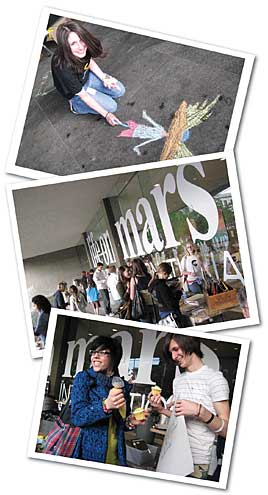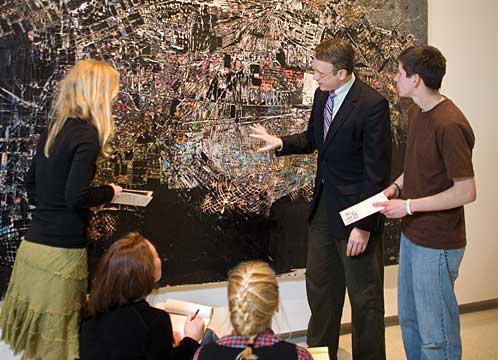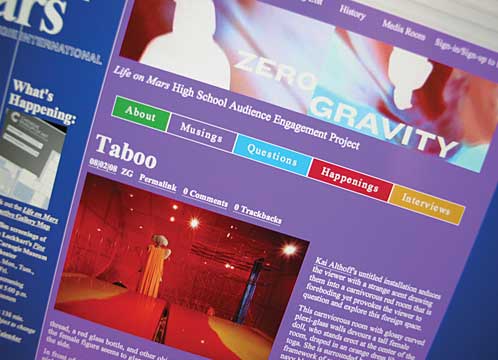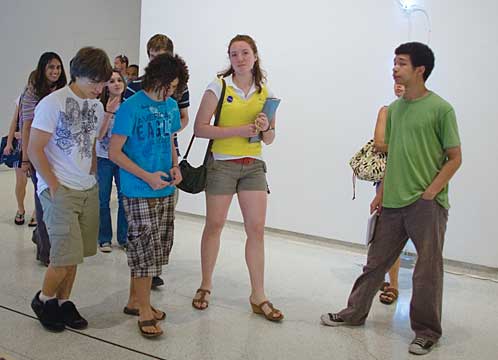Fall 2008
 |
||
Left to right, Maddy Dattilo, Phillip Hohlfeld, Tom Doyle, and Aliza Aasen inside Thomas Hirschhorn’s Cavemanman."In so many art classrooms, we’re brought up to think that the end of our duty is to decide whether we hate something or love something. But to be able to go beyond that—to be able to get past personal preferences—that has repercussions way beyond the art room.”
- Jordan Crosby, Carnegie museum of Art’s school and teacher programs specialist |
Speaking Their Language
It’s no secret that teenagers—especially today’s technology-savvy young people—speak their own language. So a first-of-its kind internship program at Carnegie Museum of Art is not only honing teenagers’ ever-important critical thinking skills, it’s incorporating their social networking know-how to extend its reach. In a Carnegie Museum of Art hallway, surrounded by friends from her 10th grade class at Mount Lebanon High School, Maura Kearns speaks in a language intentionally ripped from teenage text messaging: “There’s, like, four of us who are all BFFs,” she says, “and all our BFs are BFFs, too,” referencing her close-knit group of “best friends forever” and their boyfriends.As she speaks, Kearns twists a colorful ribbon worn around her wrist like a Lance Armstrong “Livestrong” bracelet. Rather than signaling some allegiance to cancer research or breast cancer awareness, the bracelets she and several of her teenage cohorts wear are torn from Brazilian artist Rivane Neuenschwander’s interactive installation, I Wish Your Wish, currently on view as part of Life on Mars, the 2008 Carnegie International.  More than 100 area teens descended on the Museum of Art in June for “Art Under Pressure,” an event hosted by Zero Gravity interns.“I thought it would be really stuffy,” she says of her preconceptions of the exhibition. “I thought it’d be, like,” she strokes her chin with thumb and forefinger, switching to a mock-English accent, “‘Yeesss, yeesss—now this is Ahhrrt.’ I didn’t think it’d be ‘out there.’” Kearns and her friends are pretty typical teenagers—which is exactly the point. But they’re not-so-typical, too, in that they agreed to devote a chunk of their summers to a new museum project called Zero Gravity, created to tap high schoolers’ unique and e-conscious points of view in order to reach—who else?—other high schoolers. These typical and not-so-typical teens are helping Carnegie Museum of Art look at contemporary art from a fresh, very young, and, oftentimes, very novice lens. And while Kearns, only partly in jest, had feared that her time spent around a contemporary art exhibition might require talking in the Queen’s English—a far cry from the language spoken by her BF and BFFs—in Zero Gravity, Kearns and her friends are speaking their own language. And museum educators are listening. Finding Their VoiceWith Zero Gravity, two select groups of high school students from around the region—one this past summer, one this fall—are spending months pondering Life on Mars. For four hours a week, they examine the artwork and interact with arts professionals—from curators and critics to International participants such as California graffiti-installation artist Barry McGee. The students also write, blog, and talk about the show with their peers—and, hopefully, change a few minds while they’re at it, including their own.“Before I came here, I’d see something and think, this isn’t really art—someone just smacked something up there,” says Kearns, referencing a gallery wall. “But then I started learning about the process—a lot of people contributed to that, and a lot of ideas went into that. The curator had to choose the work, they decided where and how to hang it, what kind of room it should be in—everything! And it’s really important, but I didn’t think it was. “There’s one painting, I think it’s at The Warhol, that’s almost a blank canvas,” she says. “I used to think it was lame, but now I want to go back and look at it again—I know there’s so much more for me to see.” Sharmila Venkatasubban understands that teenagers—heck, anybody—can have a hard time approaching contemporary art. “It’s simply daunting to talk about contemporary art,” says Venkatasubban, the museum educator for teen programs and leader of Zero Gravity. This summer, she guided the more than 20 students selected from more than 60 applicants, many from schools that are not close enough for ready access to the museum, such as Seneca Valley High School in Cranberry Township and Pine-Richland in Gibsonia. But through long-term engagement with Zero Gravity—four hours a week over three months—the museum hopes to build a rapport between teens and Life on Mars. “These kids are smart,” says Jordan Crosby, the museum’s school and teacher programs specialist. “They’re very self-motivated and have lots of opinions about the world to share. But they don’t always have an outlet when they come on school tours. They come, get a 60-minute tour of these fabulous works of art, and many of them never get the chance to come back. Zero Gravity is meant to give them independence, and a sense of ownership—about this museum, this particular exhibition, and contemporary art in general.” Testing the WatersCharles Youngs, an English teacher at Bethel Park High School who brings his writing classes to the museum for its “Art Inspires Narrative Writing” and “Art and Literature” tours and also serves as an advisor to Zero Gravity, thinks it’s just as crucial to simply solve the physical disconnect between young audiences and the museum. “As important as inspiring them to write through art is, it’s important just getting them to cross the threshold of the museum, and realize that art is for them, too,” Youngs notes. “Museums and fine art for a long time have been thought of as being only for certain people.” Charles Youngs, a teacher of English at Bethel Park High School, guides a discussion about a Mark Bradford painting.In recent years, events have conspired to make that threshold even more difficult to cross—even just for that 60-minute annual field trip. As Crosby explains it, the No Child Left Behind Act has caused public schools to place new, stricter emphasis on math and so-called “informational” writing. This has turned many other traditional elements of education, including art, into second-class subjects. Picasso may have changed the way we see the world, but he’s not going to increase your test scores. “Traditionally, teachers aren’t taught that looking at art, and thinking about art, can help with test scores,” says Crosby. “So we’ve been challenged to find more and more ways to conspicuously integrate non-art subjects into our gallery-based programs.” One way of doing so is included in Zero Gravity’s Thursday evening sessions: using writing exercises, which guide students through critical and aesthetic responses, to explore the more than 200 works of art in Life on Mars. Crosby and Venkatasubban want to teach the Zero Gravity students how to closely examine artwork, not just through what they’re told about art, but by “interviewing” the pieces themselves—formulating questions and working through the possible answers—and then sharing their thoughts with others. The students also post blogs on the Zero Gravity section of the Life on Mars web site, and take turns staffing the exhibition’s three computer-equipped Idea Centers. Located near the galleries, the Idea Centers are another experiment in helping visitors connect with the exhibition, and the Zero Gravity teens are lending their technology know-how to the project.  Zero Gravity section of the Life on Mars web site.They’re using skills not necessarily taught in schools, where, even when art is taught, it’s mostly in terms of “doing”—i.e. how to make a watercolor, how to sculpt. So Venkatasubban and Crosby have had to create new ways to teach kids about art—an objective supported by Pittsburgh-based philanthropic organizations The Fine Foundation and The Grable Foundation, both of which have supplied grants aimed squarely at this goal. Crosby likens it to a conversation, and recounts some advice she got from Terry Smith, professor of contemporary art history at the University of Pittsburgh. “He suggested we treat contemporary artworks in a gallery like people at a cocktail party,” she says. “Looking at art can be an avenue of learning how to exist in a more meaningful way socially in the world—how to sustain a conversation.” With this in mind, Crosby explains how Zero Gravity is a two-way street. Sure, these students are learning how to speak the language of contemporary art; but they’re also helping teach the museum how to speak their language. “Part of Zero Gravity is testing the waters,” says Venkatasubban. “We’re trying to find new programs for high school students. “These students are serving as our teen advisory committee,” she adds. “They have an opportunity to engage other teenagers that educators don’t. Throughout the program, I’ve seen them get more comfortable with this work, and hopefully that will allow them to invite other people in to talk.” Brave Acts in Zero GravityDuring a recent session, Venkatasubban sends the students into the galleries to choose one or two of their favorite works and use them as a launch pad for personal, creative writing—a poem, a short story, or, in one student’s case, a series of cartoons. Contemporary art, she tells them, is a narrative that unfolds via three storytellers: “The curator, who writes a story, the artists, who bring their stories to the narrative—and then there’s our part, as viewers. It’s not complete until we add our part.” Zero Gravity interns explore the museum.In one work, a seesaw, devoid of riders, sits at its naturally reclined angle. Above it, a flock of birds flaps like—like what? Is it like Audubon, or Hitchcock? Paul Thek’s painting of birds and seesaws, superimposed over copies of the International Herald-Tribune, can inspire many thoughts, from quiet self-reflection, to an almost eerie sentimentalism. To Mount Lebanon High School student Sasha Henry, it’s a loss of innocence—her own, and an entire generation’s. “It’s a kind of naiveté of the occurrences around the world,” says Henry. “That these birds on the seesaw are more important than everything else going on, everything in that newspaper.” It reminds her of a September morning in her childhood— not too long ago—playing kickball before school, wondering why everyone was leaving the yard. The most crucial historical event of her young lifetime was occurring at that very moment, images of planes and skyscrapers burned onto a generation’s retinas, “and all I cared about was why people kept leaving, and who was going to go next at kickball.” Henry’s response to Thek’s Seven Birds is a personal coup—a new approach, through a contemporary artwork, to something deeply important in her life. That she’s not just able to read it to her Zero Gravity classmates but also post it on the group’s web site is, perhaps, a braver act than we might give her credit for. The fictitious tale that Joelle Scarnati tells isn’t a pretty one: An artist and his muse, alone in a studio, trade cigarettes and curse words as they move from pose to pose in a series of photographs. But the arc of Scarnati’s narrative isn’t what’s important. The 17-year-old Seneca Valley High School student’s impromptu fiction resonates with the same shadowy emotion and dichromatic cinematography of its inspiration—Beat-era artist Bruce Conner’s Angel series. Scarnati sketched her story the way a painting student might copy a masterpiece, crouched on the floor of the gallery before the artwork—the photographic self-portraits that comprise the late Conner’s contribution to Life on Mars. “Certain pieces will catch my interest,” says Scarnati. “But other ones—they’ll strike me really emotionally. Like Friedrich Kunath’s painting of the silhouette of a man on a bright watercolor background—that immediately, emotionally attached to me. I viewed the exhibition during a field trip in June, and if I had just gone with that, I probably would’ve still liked certain pieces and not liked others. But spending time with the art, I’ve gotten to decide both what I think of it and what the artist might’ve been trying to say.” “Having an audience that is anybody, it really ups the ante for students to present themselves more authentically…because their audience is more authentic,” notes Youngs, who last year began working with Crosby and a group of his students on art-based blogging. “When they blog as part of Zero Gravity, it’s not just the teachers seeing their work. They’re talking to each other and other teens. And they’re representing the museum.” “In so many art classrooms,” adds Crosby, “we’re brought up to think that the end of our duty is to decide whether we hate something or love something. But to be able to go beyond that—to be able to get past personal preferences—that has repercussions way beyond the art room.” Tom Doyle, a recent graduate of Baldwin High School, is the kind of precocious teenager whose own maturity seems to have escaped him. He quotes James Joyce without pretense (“I read this book in school, Portrait of the Artist as a Young Man—you know that one?”). Perhaps more strikingly, he gets it. To him, Life on Mars has helped go beyond “love” and “hate” with regards to art, and to understand that, in art—and, perhaps, in life—it’s okay for there to be an in-between; a state that neither embraces nor condemns, but simply contemplates, like floating in Zero Gravity. “It’s almost impossible for two people to have the same view” of a contemporary artwork, says Doyle, who plans to study art preservation and restoration when he begins college this September. “Because it’s really not the piece telling you something; or even you telling the piece something, it’s collaborative. It’s not saying just one thing; it’s saying an infinite number of things. Because everyone has a different scope on life, and everyone has a different sense of beauty.” |
|
Also in this issue:
Dream Machine · Burb Appeal · Transformers · President's Note · NewsWorthy · Now Showing · Face Time: Andy Mack · Artistic License: In the Name of Hybrid Theater · Science & Nature: The Herp House · About Town: A Road Map to Scientific Treasure · Another Look: The Child Mummy
 |
Copyright © 2017 CARNEGIE Magazine. All rights reserved. |
